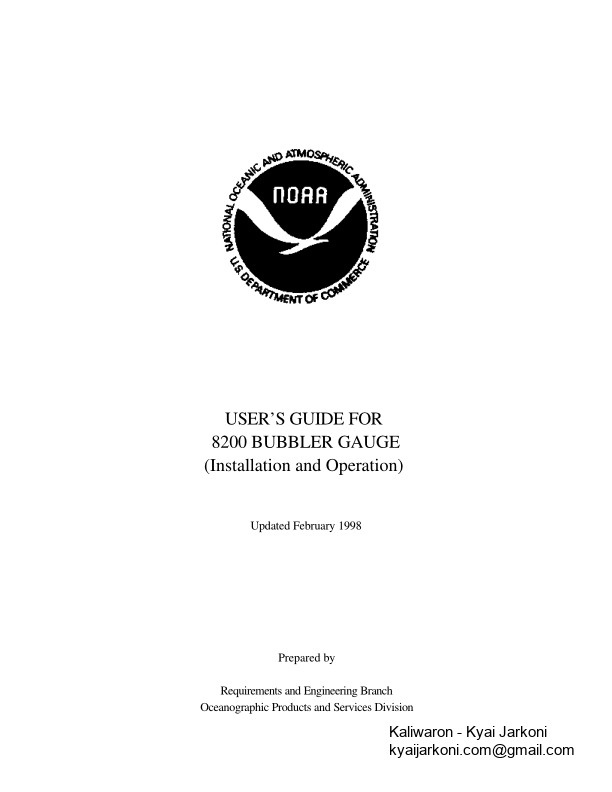Feb 18, 1998 — 8200 Bubbler Manual The Sutron 8200 digital bubbler water level gauge was developed to provide a life for the nitrogen cylinder.
40 KB – 33 Pages
PAGE – 3 ============
TABLE OF CONTENTSBACKGROUND INFORMATION.Page 1SYSTEM TRANSPORTATIONPage 2Requirements.Page 2SYSTEM INSTALLATION.Page 2General..Page 2System Tie-DownPage 7Connections..Page 71. Nitrogen supplyPage 92. Orifice connection.Page 93. Laptop connection.Page 94. Sutron 8200 connections ..Page 95. BatteryPage 11Start-UpPage 11Sutron 8200 Data Collection Platform..Page 11Bubbler control unit.Page 128200 Gauges with GOES Capability.Page 12SITE VISITSPage 13System Check..Page 13Staff Observations:..Page 13Direct Connection Data Retrieval:Page 13Battery Check..Page 13Replace Desiccant Pack:Page 13Data Retrieval – Direct Connection..Page 14Data Display – Direct ConnectionPage 16Transferring Data from Memory to a Ram Pack Cartridge ..Page 17APPENDIX A..Page 198200 DATA RECORDER SETUP.Page 19APPENDIX B .Page 25GUIDELINES FOR OPERATION AND DOCUMENTATIONOF HYDRO GAGES WITH GOES CAPABILITYPage 25APPENDIX C..Page 27SWAGELOK FITTING INSTRUCTION.Page 27
PAGE – 4 ============
8200 Bubbler Manual February 1998Page 1BACKGROUND INFORMATIONThe Sutron 8200 digital bubbler water level gauge was developed to provide a replacement system forthe traditional analog chart-recording gauges. The gauges provide:!Improved fittings, to assure more reliable and leak-free connections, allowing more operationallife for the nitrogen cylinder.!Completely electronic measurement and recording of pressure corresponding to the water level,to eliminate reliability problems caused by the chart drive, pen, and ink supply of the analog gauge.!Retrieval of station data electronically. At present, there are three methods to retrieve datafrom the measurement system: (1) by connecting a lap-top computer directly to the gauge, (2) by remotely receiving the data via line-of-sight radio communications, or (3) by GOES.!Direct entry of digital field data using diskettes into Oceanographic Products and Services Division, eliminating the manual digitization of analog chart records.The development of the digitized bubbler gauge is due to culmination of cooperative efforts fromOceanographic Products and Services Division (OPSD) at Silver Spring, MD, field activities of the Coast Survey™s Hydrographic Surveys Branch, and the Pacific Regional Office (PRO) of the Field Operations Branch (FOB) at Seattle, WA. Close interaction between all parties involved has resulted in measurement system modifications while taking into account suggestions and comments from the field user and maintaining the measurement performance and system compatibility required for data analysis.General procedures on system installation and operation are summarized in this document. Each gaugeenclosure contains a page of brief operating instructions summarized from this manual, setup parameters for the Sutron 8200 data collection platform, and a log sheet for recording field visits, operational problems, and/or services (e.g., battery replacement, etc.).
PAGE – 5 ============
8200 Bubbler Manual February 1998Page 2SYSTEM TRANSPORTATIONRequirements:!Remove the system main battery.!Secure loose components within the enclosure, tools, mounting brackets, desiccant bags, etc.!Insert foam padding or bubble pack material if necessary to avoid damage during shipment.!Open outlet valve on bubbler control unit prior to air shipping.!Use shipping containers (cardboard boxes) and packing material to protect the enclosure andthe system battery.SYSTEM INSTALLATIONGeneralThe digitized bubbler system is self-contained within a weatherproof polyester fiberglass reinforcedenclosure. The system (refer to Figure 1) consists of a Sutron 8200 data collection platform (a); a bubbler control unit (b) containing pneumatic control elements along with the pressure sensor and temperature sensor (see block diagram in Figure 2); a battery (c); and interface connections for the nitrogen supply (f), the orifice tubing (e), the portable computer (h) and the line-of-sight radio antenna (g).Caution:The systems utilize a 15 psig pressure sensor; this limits themaximum height of water above the orifice to 34 feet. Greater water heights can cause calibration shifts; heights greater than 65 feet will cause permanent sensor damage.
PAGE – 10 ============
8200 Bubbler Manual February 1998Page 7System Tie-DownSeveral attachment points are available on the bubbler system enclosure to provide for tie-down at thefield site (refer to Figure 1):!Metal brackets are provided with each system which can be bolted at each corner onthe rear of the enclosure (“m” on Figure 1).!A recessed carrying handle is located at the top of the enclosure; looping cables through thishandle on each side would provide a four-point tie-down of the enclosure. If this method is selected, location of the front anchor points must be such that the tie-down cables do not interfere with the enclosure door (“k” on Figure 1).!Handles have been added on each side of the enclosure which can also be used for tie-downpurposes (“j” on Figure 1).Figure 2 depicts the block diagram of the components inside the bubbler control unit. ConnectionsAll external connections are located on the lower right side of the enclosure. The connections havebeen recessed to avoid possible entanglement during transportation to the deployment site. Connection of the digitized bubbler to the nitrogen supply and to the orifice line during deployment will require 7/16, 9/16, 11/16, and 1 inch open wrenches, an adjustable wrench, and a screwdriver.The Swagelok fittings on the enclosure have retaining rings attached so that two wrenches are notrequired to attach the orifice and nitrogen source hoses. Excessive torque in making theseconnections, however, must be avoided. In Appendix C, a copy of instructions for Swagelokfittings is provided. Note the difference between new installation (1&1/4 turns past finger tight for 1/4inch and larger tubing sizes) and re-tightening (only 1/4 turn past finger tight). Tightening beyondthese points will damage the mating surfaces, and result in a gas leak.If necessary, the polyethylene orifice tubing can be extended or repaired by joining pieces withSwagelok fittings. In order to avoid leaks, however, be sure that the tubing end is cut square and smooth, and that the tubing is free from scratches in the area that will be inserted in the fitting.
40 KB – 33 Pages
